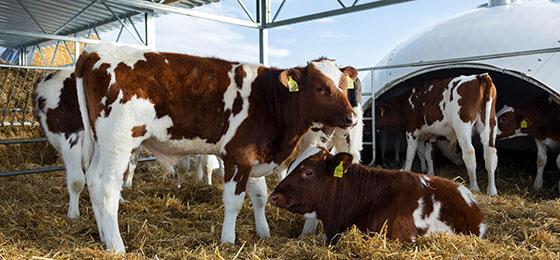Significantly less antibiotics for "outdoor calves"

Encouraging results of the project "Outdoor calf": the use of antibiotics can be reduced to one fifth! Researchers are now looking at how this impacts antibiotic resistance.
A research project of NRP 72 proposes an "outdoor calf" concept that differs in three main areas from standard calf husbandry: first, calfs are purchased on local farms only and any contact with other calves is avoided during transport. Second, they are not introduced into a larger group immediately, instead they are quarantined in outdoor calf igloos for single animals. In addition, they are vaccinated for pneumonia.
Third, the calves are kept in small groups of up to ten animals for the rest of the five-month fattening period. They are housed in group igloos in combination with a bedded and sheltered outdoor area. This concept was applied to 19 calf farms and compared with 19 traditional calf farms in the same region.
Drastic reduction of antibiotics
The results are very clear: calves raised according to the new concept were given five times less antibiotics than traditionally raised calves. Expressed in the common unit "daily doses per animal year" this corresponds to 6 daily doses vs. 31 daily doses - the latter figure being more or less average for European countries, according to project leader Mireille Meylan.
Fewer cases of pneumonia
The quarantine and the vaccination upon arriving at the farm help avoiding the spread of disease. But these initial measures are not the only reasons the use of antibiotics could be reduced. The general health of the animals is improved and this contributes to the reduction in antibiotics used: on farms without outdoor concept, more than half the animals received antibiotics at least once during their lifetime, while only every sixth outdoor calf needed antibiotics.
The main difference was that outdoor calves showed fewer symptoms of pneumonia, as researchers noticed during monthly check-ups. "This is relevant because pneumonia is the main reason antibiotics are used in calf husbandry," says vet Jens Becker, who did the majority of the farm check-ups.
Impact on resistance
But researchers weren't only interested in the frequency with which antibiotics are used, they also wanted to find out more about the link between usage and bacterial resistance. For this reason, they took two swabs of each calf, one at the beginning of the fattening period and one at the end.
"We took one sample in the throat, where you find heaps of bacteria of the pasteurella species which can, under certain circumstances, cause pneumonia," says Becker.
At the same time they took a swab sample of E. coli bacteria in the colon. These bacteria are not a problem in themselves, but because they are always present in the gut, they are ideal for observing the development of resistance.
Studying the link first hand
In a recent study, Mireille Meylan and colleagues were able to show that there is a link between resistance and the frequency and duration of antibiotic treatments. "We analysed samples from over forty fattening farms," she says. "A clear pattern was apparent: the resistance to certain antibiotics increased in line with the frequency of group treatments using these antibiotics."
By means of the samples taken during the "outdoor calf" study, which are still being analysed, she hopes to show how the change in animal husbandry and the linked reduction in antibiotic use will impact the resistance situation.
